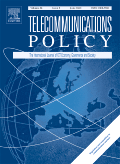
TELECOMMUNICATIONS POLICY
Scope & Guideline
Innovative Research for Evolving Communication Landscapes
Introduction
Aims and Scopes
- Policy Analysis and Development:
The journal emphasizes the analysis and development of telecommunications policies, examining how regulatory frameworks affect the telecommunications sector and its users. - Digital Divide and Inclusion:
A consistent focus on the digital divide, exploring issues of access, equity, and inclusion in telecommunications, particularly in rural and underserved areas. - Impact of Technology on Society:
Investigating the societal implications of new technologies such as 5G, blockchain, and IoT, and their effects on economic growth, job creation, and social dynamics. - Economic Analysis of Telecommunications:
Utilizing economic theories and empirical evidence to analyze the economic impacts of telecommunications, including market structures, competition, and consumer behavior. - Global Perspectives on Telecommunications:
Incorporating diverse global perspectives, particularly from developing regions, to understand the unique challenges and opportunities in telecommunications policy. - Sustainability and Telecommunications:
Exploring the relationship between telecommunications and sustainability, including environmental impacts and the role of digital technologies in promoting sustainable practices.
Trending and Emerging
- Impact of 5G and Future Technologies:
There is a growing emphasis on the implications of 5G technology and beyond, exploring its economic, social, and regulatory impacts, as well as its role in enabling new applications. - Blockchain and Digital Transformation:
Research focusing on blockchain technology's role in telecommunications and its potential to transform business models and regulatory practices is gaining traction. - Data Privacy and Protection:
With increasing concerns over data privacy, studies examining the implications of data protection laws and consumer attitudes towards privacy are becoming more prominent. - Digital Economy and Inclusivity:
The exploration of the digital economy's role in promoting inclusivity and addressing issues such as income inequality and access disparities is an emerging focal point. - Climate Impact and Sustainability:
Research on the environmental implications of telecommunications, particularly regarding energy consumption and carbon emissions, is increasingly relevant in the context of global sustainability efforts. - AI and Governance:
The intersection of artificial intelligence and telecommunications governance is becoming a significant theme, particularly in relation to ethical considerations and regulatory frameworks.
Declining or Waning
- Traditional Telecommunication Regulation:
There appears to be a declining focus on traditional forms of telecommunication regulation, as newer technologies and market dynamics shift the conversation towards more innovative regulatory approaches. - Simple Infrastructure Deployment:
Research specifically centered on basic infrastructure deployment is becoming less frequent, with a shift towards examining complex interactions between technology, policy, and socio-economic factors. - Single Country Case Studies:
There is a noticeable decrease in single-country case studies, as more comparative and global analyses are favored to capture broader trends and implications. - Basic Consumer Behavior Studies:
Studies focusing solely on basic consumer behavior are waning as the field moves towards more complex analyses that incorporate socio-economic variables and technological impacts. - Conventional Economic Models:
The reliance on traditional economic models without integration of technological advancements and consumer behavior is declining, reflecting a need for more nuanced frameworks.
Similar Journals

Cimexus
Exploring the Depths of History and CultureCimexus is a distinguished academic journal published by the Instituto de Investigaciones Históricas at Universidad Michoacana de San Nicolás de Hidalgo, focusing on the rich field of historical and cultural studies. With the ISSN 1870-6479 and E-ISSN 2007-9206, Cimexus has been an Open Access publication since 2006, promoting unrestricted dissemination of research to enhance collaboration and innovation. Situated in Morelia, Michoacán, Mexico, this journal serves as a vital platform for scholars and researchers dedicated to exploring the complexities of history and culture, thereby making significant contributions to the academic community. Through rigorous peer review and a commitment to high-quality research, Cimexus seeks to foster impactful discourse and provide visibility to pioneering studies in historical inquiry, encouraging engagement among professionals, researchers, and students alike.

Netnomics
Navigating the Complexities of the Digital MarketplaceNetnomics, published by SPRINGER, is a pivotal academic journal focusing on the intersection of economics, computer networks, and information systems. With its ISSN 1385-9587 and E-ISSN 1573-7071, this journal strives to address current trends and research challenges in the digital economy, effectively capturing the dynamics of online markets and digital goods. Although open access options are not available, Netnomics maintains an impressive standing, ranking in the Q3 category for its fields in Computer Networks and Communications, Economics and Econometrics, and Information Systems. Despite its discontinuation of coverage in Scopus from 2005 through 2021, the journal continues to contribute valuable insights, making it a relevant source for researchers, professionals, and students eager to explore the evolving landscape of economic interactions in a digitalized world. With a focus on empirical research and theoretical analysis, Netnomics provides a platform for advancing knowledge at the confluence of technology and economic theory, critical for professionals navigating the complexities of today's economy.
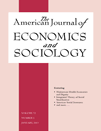
AMERICAN JOURNAL OF ECONOMICS AND SOCIOLOGY
Fostering Interdisciplinary Insights for a Better Tomorrow.American Journal of Economics and Sociology is a distinguished peer-reviewed journal published by Wiley that serves as a vital platform for researchers and professionals in the fields of economics and sociology. With a publication history spanning from 1941 to the present, this journal covers a diverse range of topics, promoting interdisciplinary research and fostering a deeper understanding of social and economic phenomena. Although it operates on a traditional subscription model, its contributions are widely recognized, earning it an impactful position within the academic community, reflected in its current 2023 Scopus Rankings— positioned in the top quartile for Sociology and Political Science and notable recognition in Economics and Econometrics. The journal is based in the United Kingdom and aims to enhance discourse and collaboration across economic and sociological domains, making it an essential resource for students, educators, and policymakers alike.

International Journal of Electronics and Telecommunications
Fostering Collaboration in Electronics and TelecommunicationsWelcome to the International Journal of Electronics and Telecommunications, a prominent publication dedicated to the evolving fields of electronics, telecommunications, and computer networks. Established by the Polska Akademia Nauk (Polish Academy of Sciences), this journal is committed to fostering academic research and technological advancements within these crucial domains. As of 2023, it holds a Q4 ranking in both Computer Networks and Communications and Electrical and Electronic Engineering, showcasing its role as a platform for emerging ideas and groundbreaking studies. With an Open Access model implemented since 2013, it enhances the visibility and accessibility of its articles, encouraging a broader impact and collaboration among researchers, professionals, and students alike. The journal serves as an important resource for those interested in the intersection of technology and communications, and it continues to contribute to the academic dialogue surrounding these vital sectors.

Journal of E-Learning and Knowledge Society
Championing Open Access to Knowledge and LearningJournal of E-Learning and Knowledge Society is a premier academic journal dedicated to the exploration and advancement of e-learning and knowledge dissemination in contemporary society. Published by the SOC ITALIANA E-LEARNING, this journal has established itself as a vital resource for researchers and practitioners since its inception in 2006. With an open access model adopted in 2007, the journal promotes the free exchange of ideas and research findings, ensuring wide accessibility to academic contributions in this rapidly evolving field. The journal is indexed in notable databases and holds a Q3 classification in both Computer Science Applications and Education, reflecting its significant role in the advancement of educational technologies. Furthermore, its Scopus ranks highlight its relevance within the educational and computer science communities. Based in Rome, Italy, the Journal of E-Learning and Knowledge Society aims to bridge the gap between theory and practice, providing a platform for innovative research that shapes the future of digital learning environments. Whether you are a researcher, educator, or student, this journal offers valuable insights and developments in e-learning that are critical to navigating today’s knowledge society.
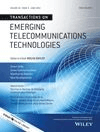
Transactions on Emerging Telecommunications Technologies
Illuminating the Path of Next-Gen Telecom SolutionsTransactions on Emerging Telecommunications Technologies, published by WILEY, is a prestigious academic journal that has been at the forefront of electrical and electronic engineering since its inception in 2012. With an impressive Impact Factor that places it in the Q1 category of the field, this journal aims to disseminate groundbreaking research and technological advancements that shape the next generation of telecommunications. Operating under an Open Access model, it ensures that valuable insights and innovations are readily accessible to a global audience, fostering collaboration among researchers, professionals, and students alike. Housed in the United Kingdom, it is strategically positioned within a vibrant community of scholars and industry experts. As of 2023, the journal ranks #116 out of 797 in its category according to Scopus, reflecting its high visibility and impact within the academic community. The journal continues to be a vital resource for those looking to stay informed about emerging trends and developments in telecommunications technology.
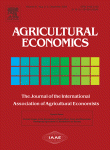
AGRICULTURAL ECONOMICS
Elevating understanding of global agricultural dynamics.AGRICULTURAL ECONOMICS, published by Wiley, is a premier journal dedicated to advancing the understanding of agricultural economics, with an ISSN of 0169-5150 and an E-ISSN of 1574-0862. This esteemed publication serves as a vital resource for researchers, professionals, and students in the fields of Agronomy and Crop Science, as well as Economics and Econometrics, consistently reflecting its high standing as evidenced by its 2023 Q1 ranking in both categories. With a comprehensive scope spanning from 1986 to 2024, the journal presents rigorous analysis and innovative research that informs policy decisions and enhances agricultural practices globally. Although it does not provide open access options, the rich academic content invites a dedicated readership committed to strengthening the agricultural sector through evidence-based insights. The journal is particularly noted for its impressive Scopus rankings, placing it among the top-tier resources for understanding the complex interplay between economic theory and agricultural development.
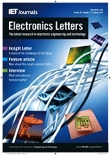
ELECTRONICS LETTERS
Advancing Knowledge in Electrical Engineering.ELECTRONICS LETTERS, published by WILEY, is a leading peer-reviewed journal dedicated to the field of Electrical and Electronic Engineering. With a rich history dating back to 1965, this journal serves as a prominent platform for disseminating novel research and innovations in electronics, covering topics such as circuit design, telecommunications, and signal processing. In 2021, the journal transitioned to an Open Access format, ensuring that cutting-edge research is freely accessible to a global audience, thereby enhancing its impact and outreach. The journal currently holds a Q3 quartile ranking in its category, reflecting its solid position among its peers, and ranks #451 out of 797 in Scopus for Electrical and Electronic Engineering, placing it within the 43rd percentile. ELECTRONICS LETTERS is essential for researchers, professionals, and students looking to stay abreast of the latest developments and contribute to advancements in the field, fostering collaboration and knowledge sharing in a rapidly evolving landscape.

Transport and Telecommunication Journal
Transforming Transport Through Open Access InsightsTransport and Telecommunication Journal is a premier open-access publication dedicated to advancing the fields of transport and telecommunications. Published by SCIENDO, this journal has been providing a platform for innovative research and discussions since 2008, catering to a global audience. With a current impact factor that reflects its growing influence in the academic community—ranking in the Q3 quartile for both Computer Science Applications and Engineering (Miscellaneous)—its articles cover a wide range of topics pertinent to contemporary transport challenges and the integration of telecommunications technology. Notably, the journal's reach extends internationally from Latvia, promoting accessibility and collaboration across borders, as it has been fully open access since 2012. Researchers and professionals are encouraged to contribute to this dynamic forum, where cutting-edge studies and insights into engineering and computer science disciplines converge.

Journal of Information Policy
Championing Open Access in Information ResearchThe Journal of Information Policy is a premier academic publication endorsed by PENN STATE UNIV PRESS that has been championing open access research since 2011. Dedicated to advancing the field of information policy, this peer-reviewed journal plays a pivotal role in disseminating scholarly work at the intersection of communication, public administration, sociology, and political science. With an impressive Editorial Board and a focus on contemporary issues regarding information governance, access, and policy implications, the journal holds substantial rankings within various disciplines, including Q2 in Communication and Sociology and Political Science, as well as Q3 in Public Administration as of 2023. It boasts a solid reputation in academic circles, ranking #210 in Communication, #570 in Sociology, and #135 in Public Administration within Scopus. With its commitment to fostering knowledge sharing among researchers, professionals, and students, the Journal of Information Policy is essential for anyone looking to explore the dynamic landscape of information policy and its impact on society.